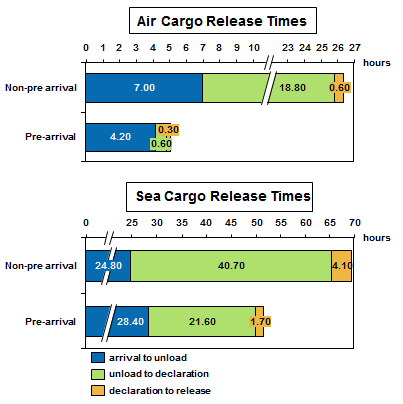Optional. Learn how pre-arrival processing is linked to risk management.
Pre-arrival processing
Definition/Scope
Pre-arrival processing involves the (electronic) submission of the relevant goods and/or cargo declaration data to the relevant authorities prior to the arrival (for import) or prior to departure (for export) of goods. Authorities are then able to conduct risk assessment and to process the declaration with a view to prepare the release decision prior to the goods arriving at the port of entry/port of exit, thus enabling the release of the goods immediately upon arrival. This may include communicating the release decision to the persons concerned so that they can continue their supply chain and logistics planning.
Problem statement
Traditionally, Customs allows importers and their agents to declare the goods only after they have arrived in the country and are presented to Customs. Consequently, Customs and other relevant authorities only then start to check and examine the declaration and prepare a release decision. This significantly delays the release process, as Customs and the other relevant agencies do not make use of the time afforded by the sometimes long journey of the goods to the country of importation, for risk assessment and declaration processing purposes.
Also, in a growing number of countries, the pre-arrival declaration option is increasingly converted into an obligatory supply chain security regime, in some cases with time limits prior to the departure of the goods in the country of export. This practice is adversely affecting trade and just-in-time supply chains and adds significant cost to doing business.
Implementation guidance
Voluntary pre-arrival declaration and processing arrangements are the solution to expedite release. According to Standard 3.25 of the Revised Kyoto Convention (RKC), Customs shall allow the lodging and registering of goods declarations and supporting documents prior to arrival of goods. According to a Time Release Study conducted by Japan Customs in 2009, (see chart), the time required to release sea cargo in a non-pre-arrival mode was 2,9 days compared to 2,2 days in a pre-arrival mode. In the case of air cargo, only pre-arrival declarations enabled Japan Customs to grant almost immediate release.

At the same time, as stipulated by Standard 3.23 of the RKC, if Customs sets a time limit for lodging the goods declaration (even in a pre-arrival mode), the time allowed shall be sufficient to enable the declarant to complete the goods declaration and to obtain the supporting documents/information required.
For authorized traders, authorities should also give due consideration to the possibility of releasing goods even prior to their arrival (so called pre-clearance), in particular for trusted traders as stipulated in paragraph 2.3 of the WCO Immediate Release Guidelines.
A prerequiste for the introduction of pre-arrival processing are a customs automation system that can receive and process the advance declaration and a risk management system in place.
Additional information (references, examples, etc.)
The ICC Customs Guideline # 9 provide relevant business perspectives on the application of pre-arrival processing.
